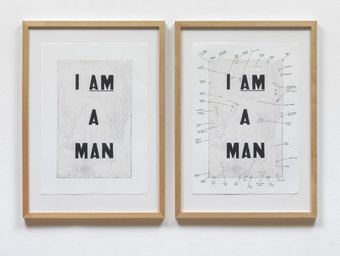
Glenn Ligon, Condition Report 2000. Lent by the American Fund for the Tate Gallery 2007. © Glenn Ligon; courtesy Thomas Dane Gallery, London.
Democracies
What does democracy mean to you?
This display brings together artworks that look at what it means to live in a democracy. A democratic society is based on equality, protecting each person’s individual rights and upholding ideals such as freedom of speech. Often presented as ideal, there are in fact challenges in democratic societies. Marginalised groups have fought and continue to fight for recognition and representation. While extreme political groups test the limits of freedom of speech and the right to protest.
On display are artworks by Artur Żmijewski and Jenny Holzer who explore political views from extreme left to far right. In her work I Want a President 1992, Zoe Leonard argues for LGBTQIA+ and class-conscious politics. While Glenn Ligon and Lubaina Himid reference issues that Black people have faced; fighting exploitation and struggling to gain and protect their rights. Although UK and global politics have changed since many of these artworks were made, the issues raised continue to be relevant today.
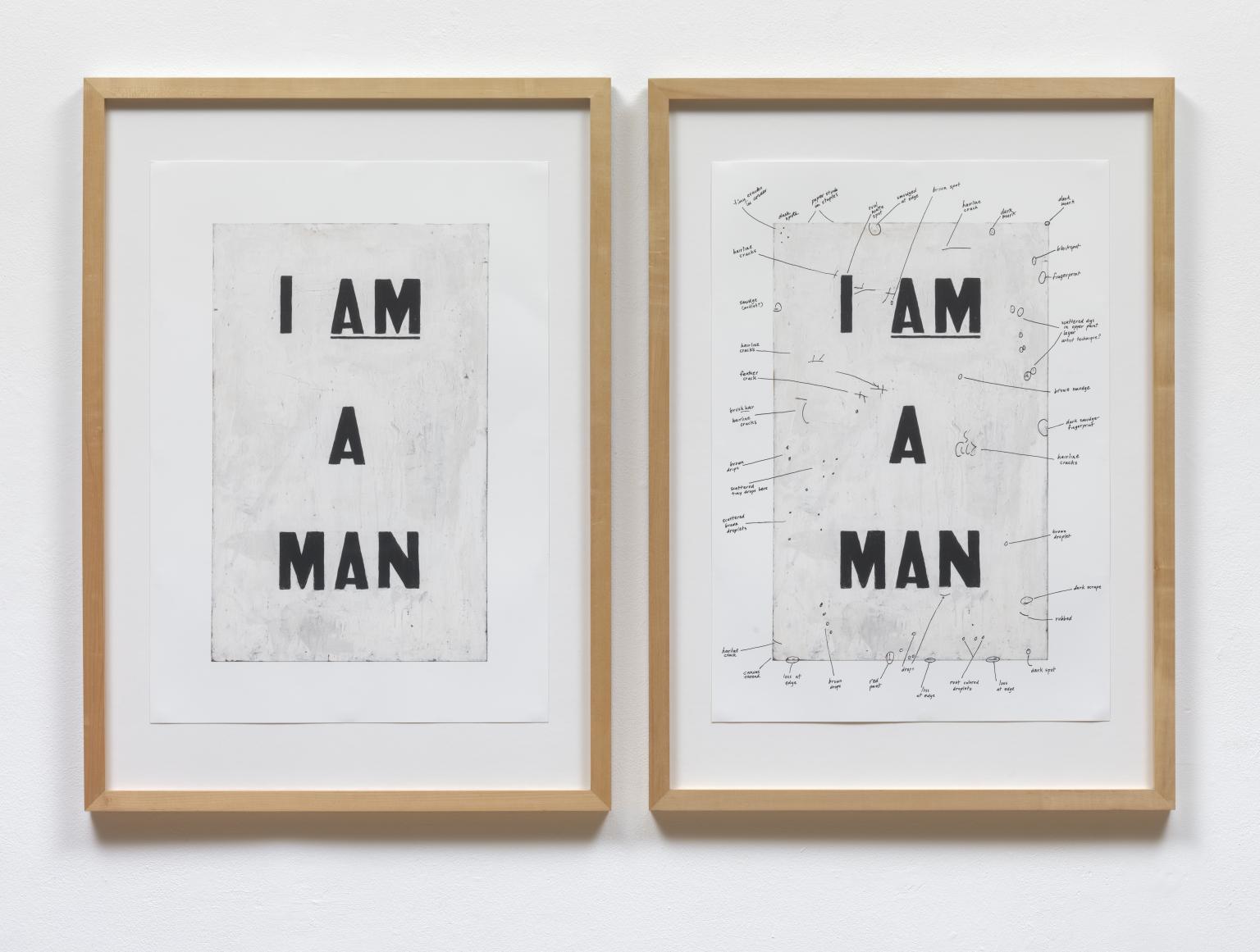
Glenn Ligon, Condition Report 2000
Untitled (I Am a Man), a 1988 painting by Ligon, takes its text from signs carried by striking black sanitation workers in Memphis in 1968. The slogan ‘I Am a Man’ was a way of protesting that they were equal to their white counterparts, who were paid more for doing the same job. Here Ligon juxtaposes a reproduction of the 1988 painting with another that has been annotated by a conservator making a condition report on the work. The imperfections noted might simultaneously be read as a questioning of the self as well as recording the frailties of the object.
Gallery label, June 2010
1/28
artworks in Democracies
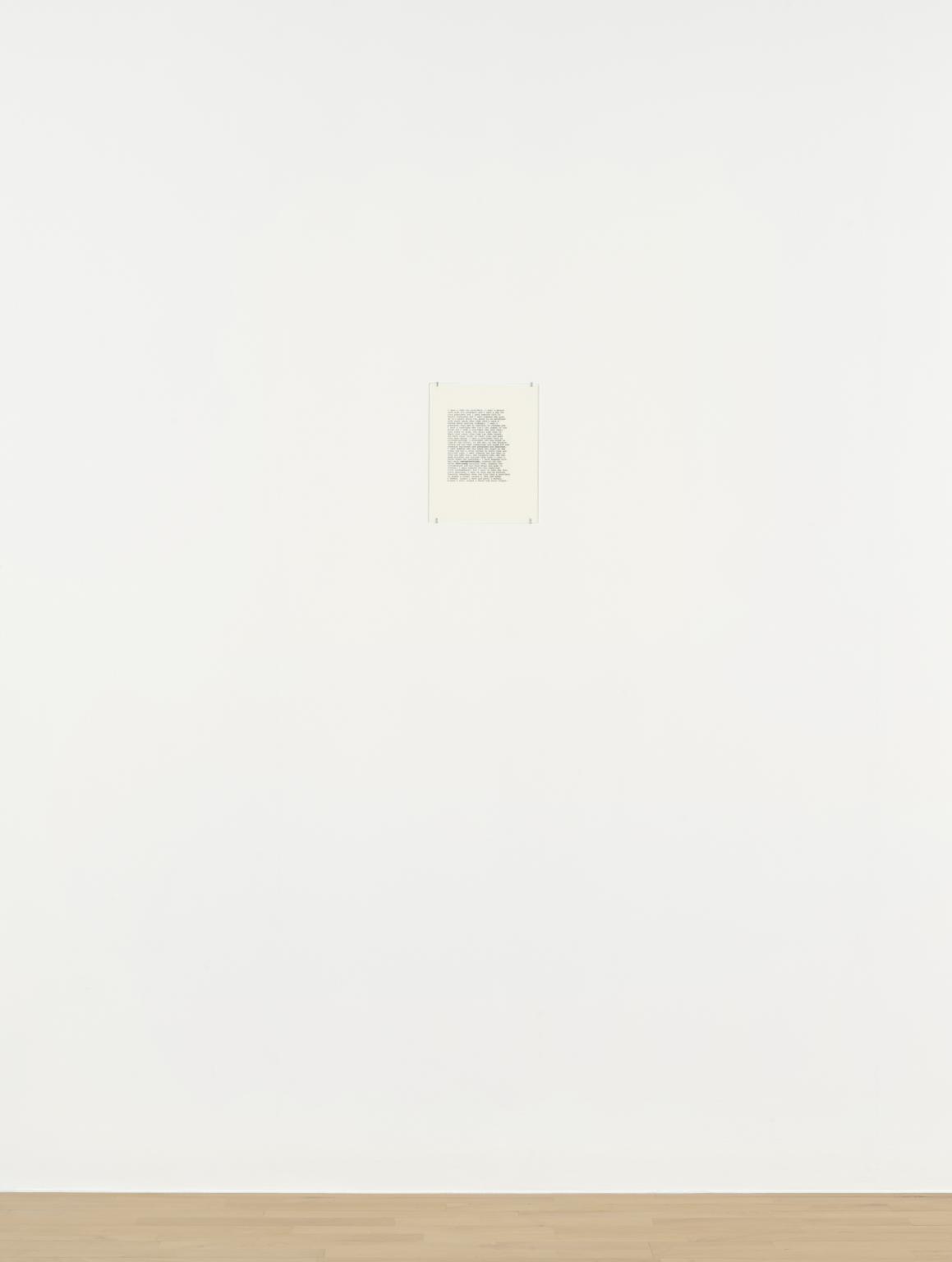
Zoe Leonard, I want a president 1992/2018
2/28
artworks in Democracies
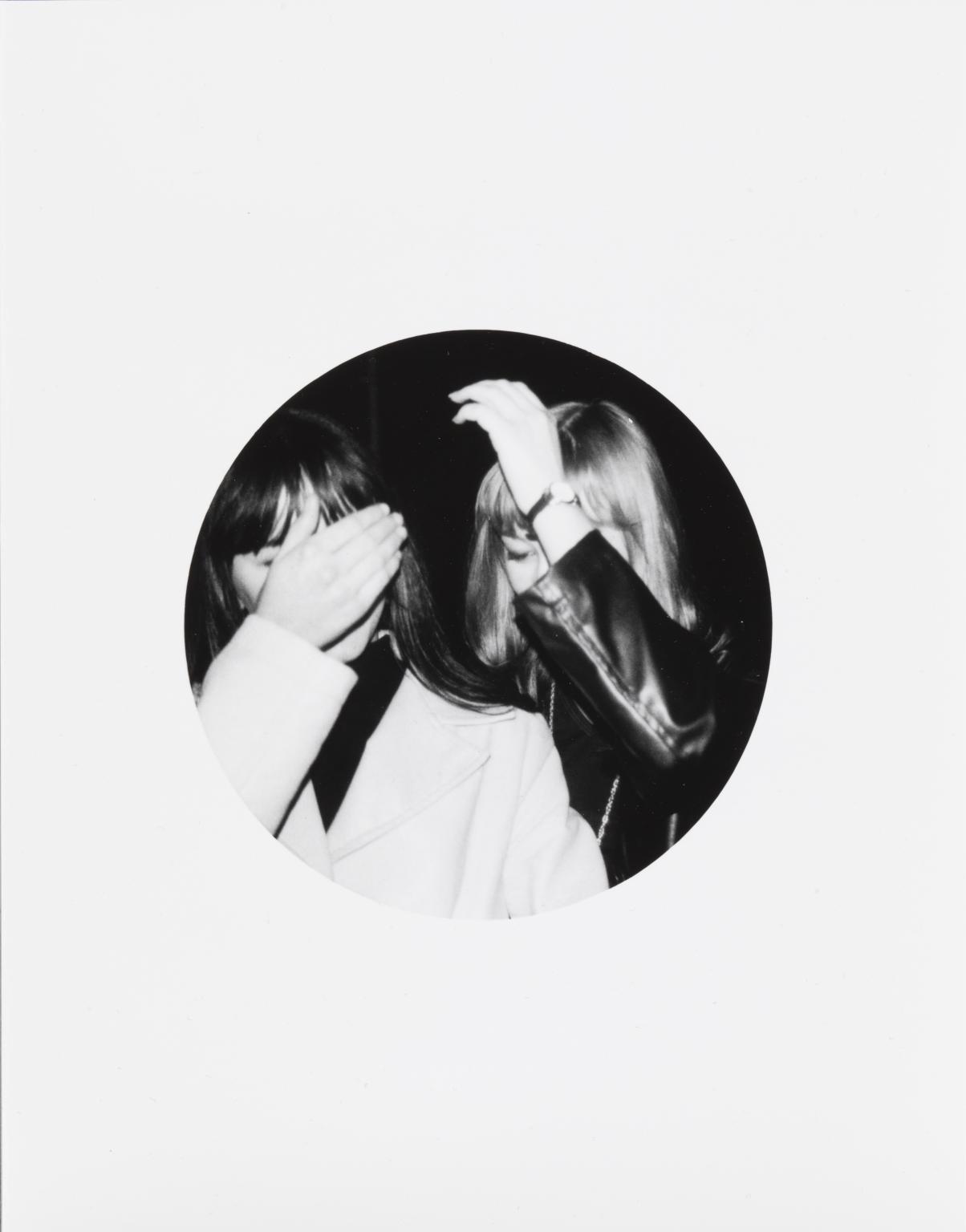
Adam Broomberg, Oliver Chanarin, Untitled (Two women hiding) 2010
3/28
artworks in Democracies
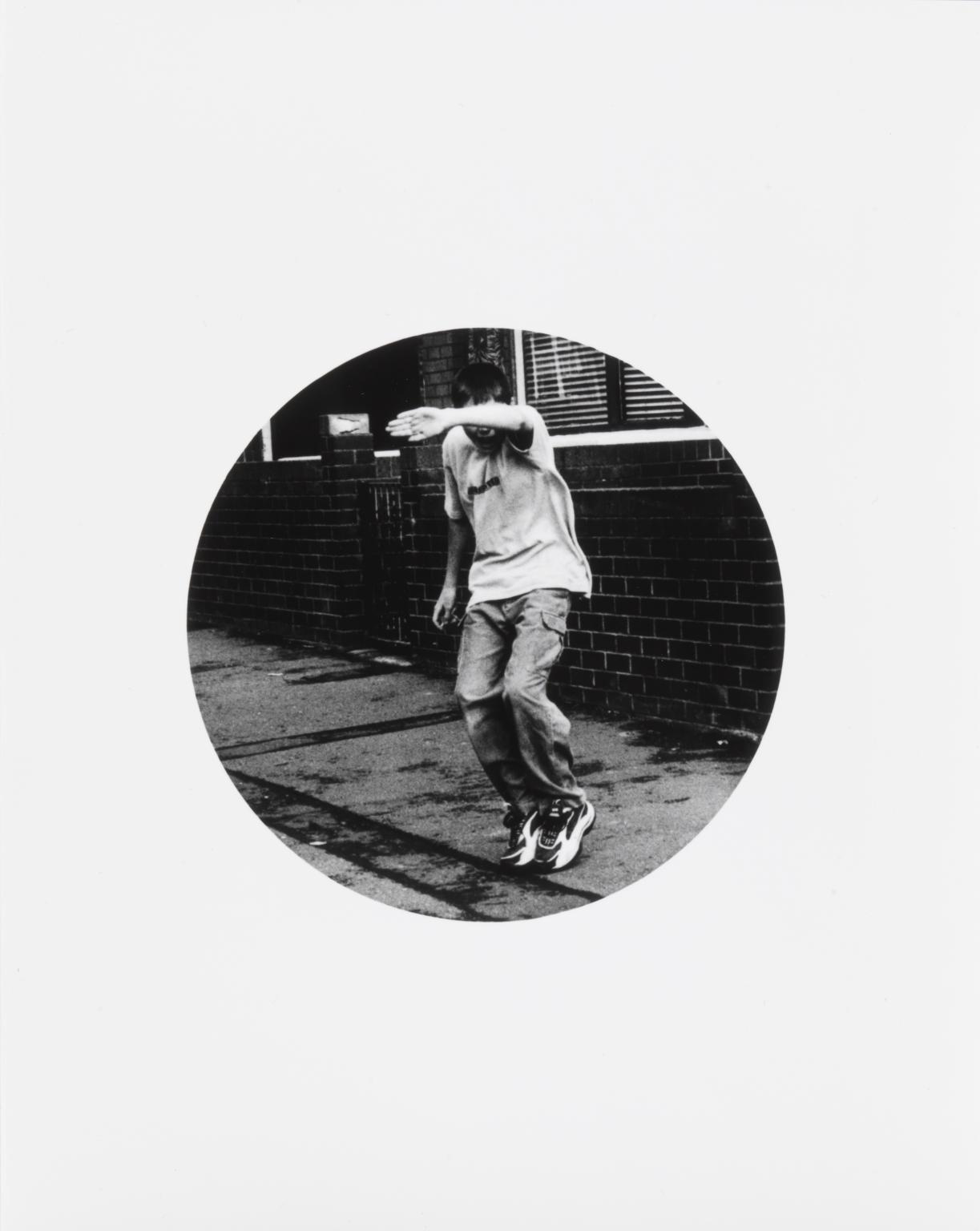
Adam Broomberg, Oliver Chanarin, Untitled (Boy on tip toes) 2010
4/28
artworks in Democracies
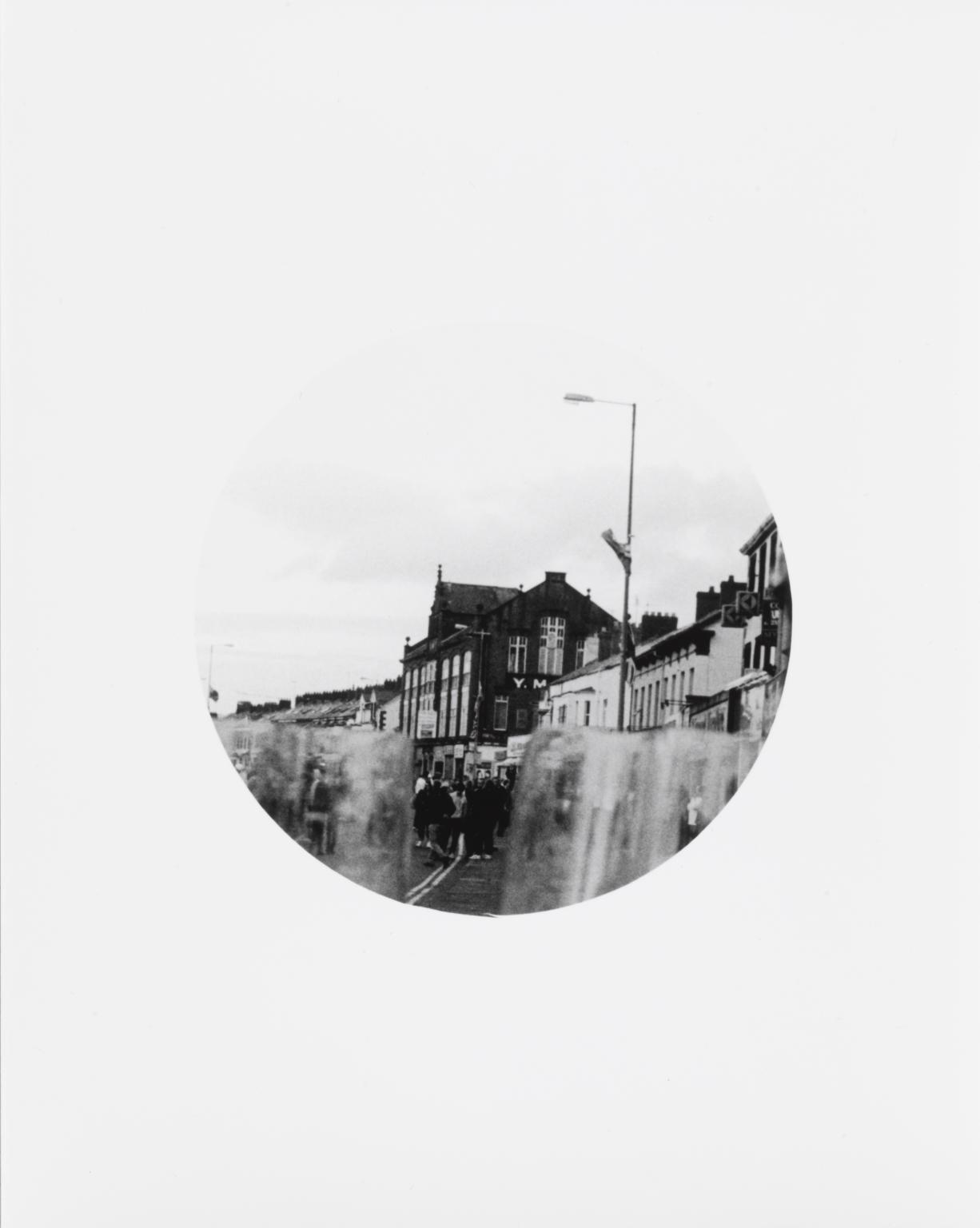
Adam Broomberg, Oliver Chanarin, Untitled (Riots shields in the high street) 2010
5/28
artworks in Democracies

Adam Broomberg, Oliver Chanarin, Untitled (People saluting) 2010
6/28
artworks in Democracies
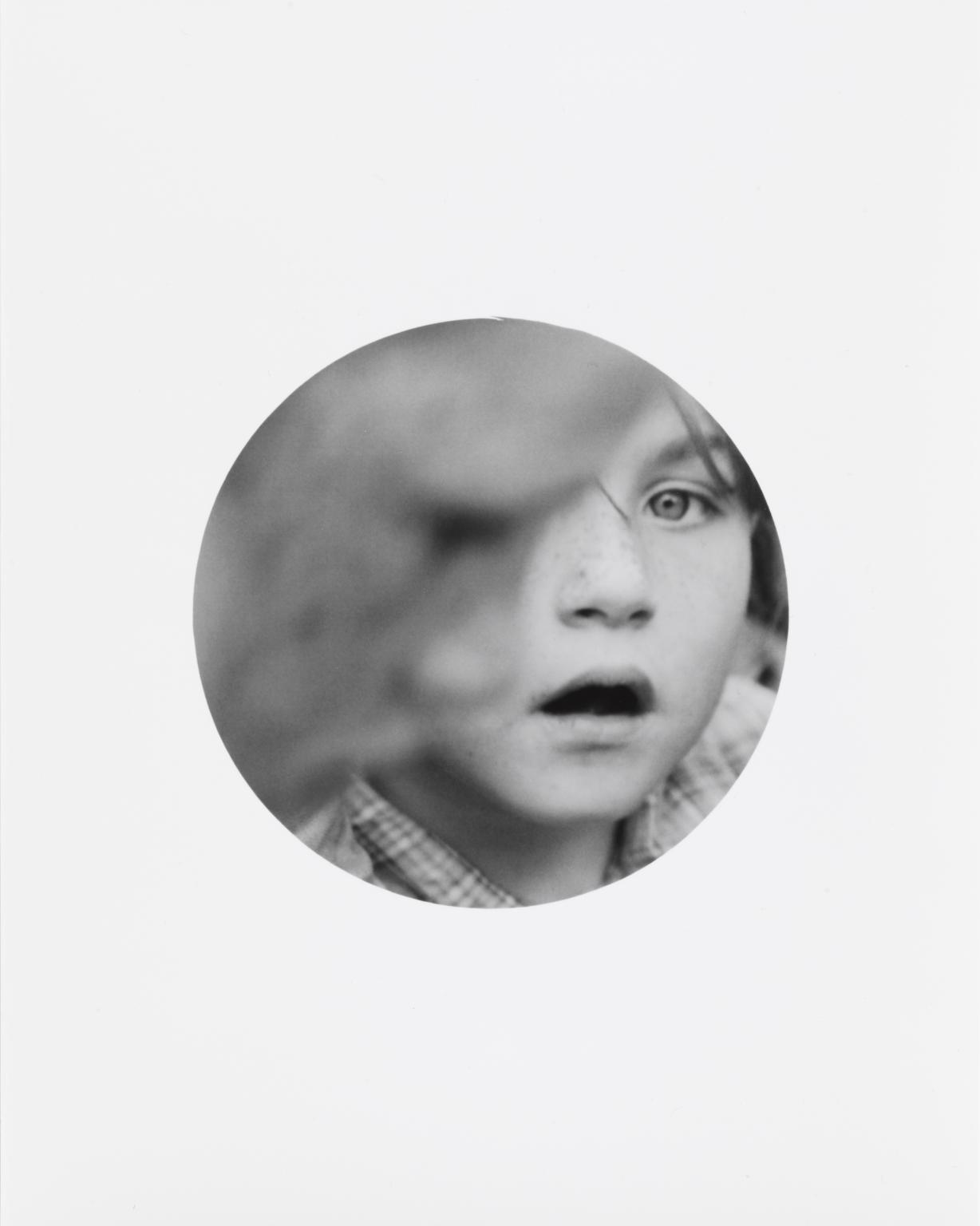
Adam Broomberg, Oliver Chanarin, Untitled (Girl looking) 2010
7/28
artworks in Democracies
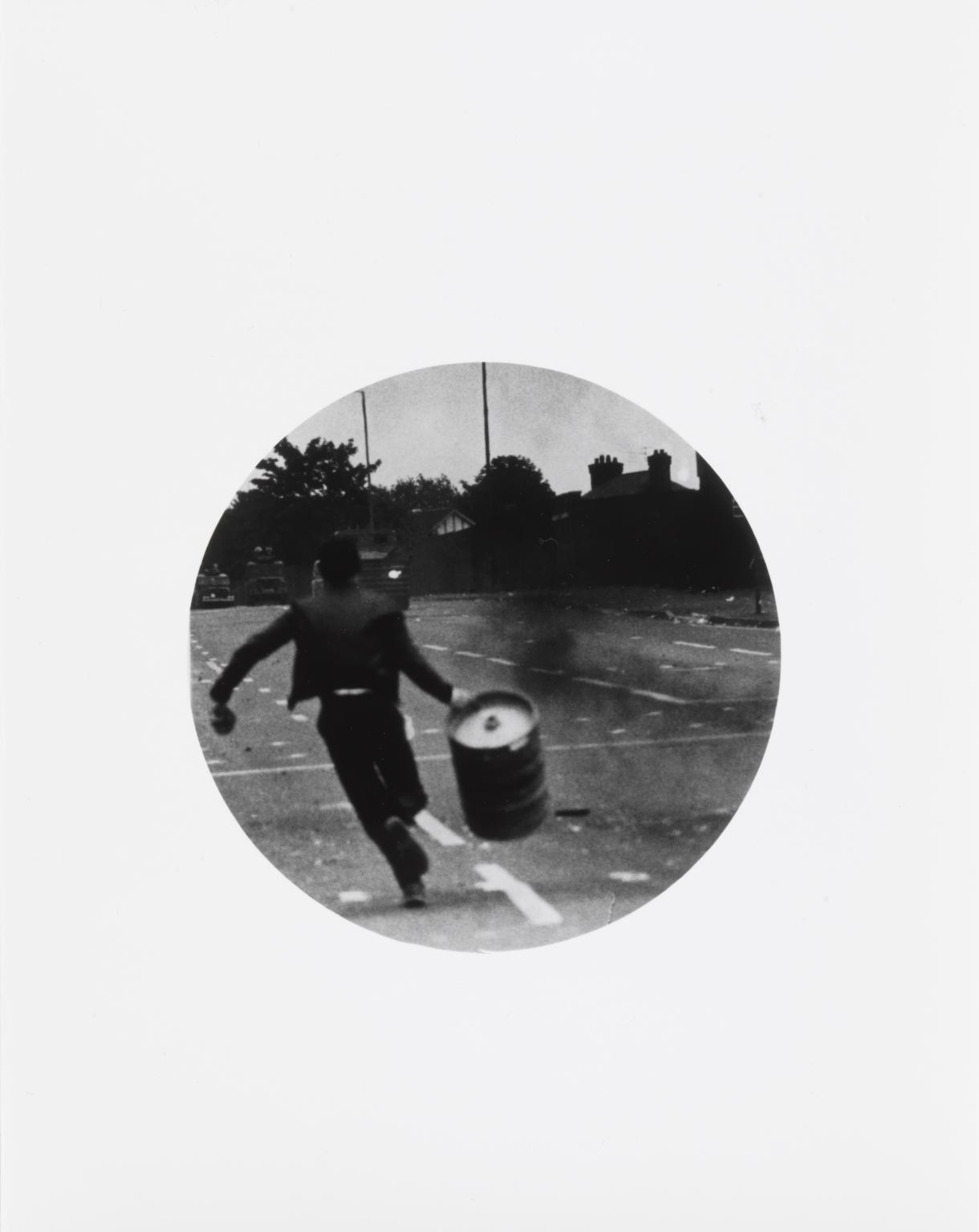
Adam Broomberg, Oliver Chanarin, Untitled (Boy running with barrel) 2010
8/28
artworks in Democracies
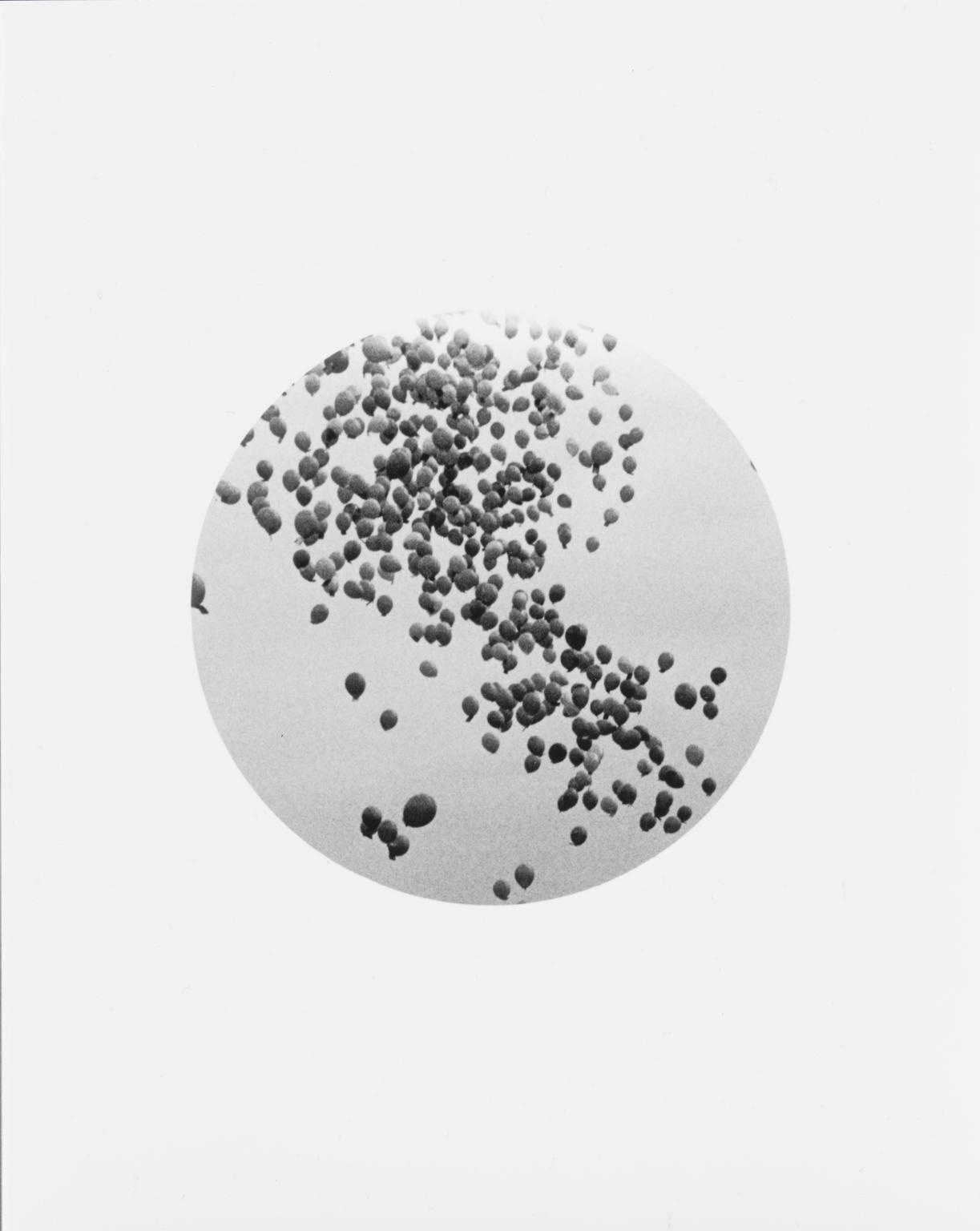
Adam Broomberg, Oliver Chanarin, Untitled (Balloons escaping) 2010
9/28
artworks in Democracies
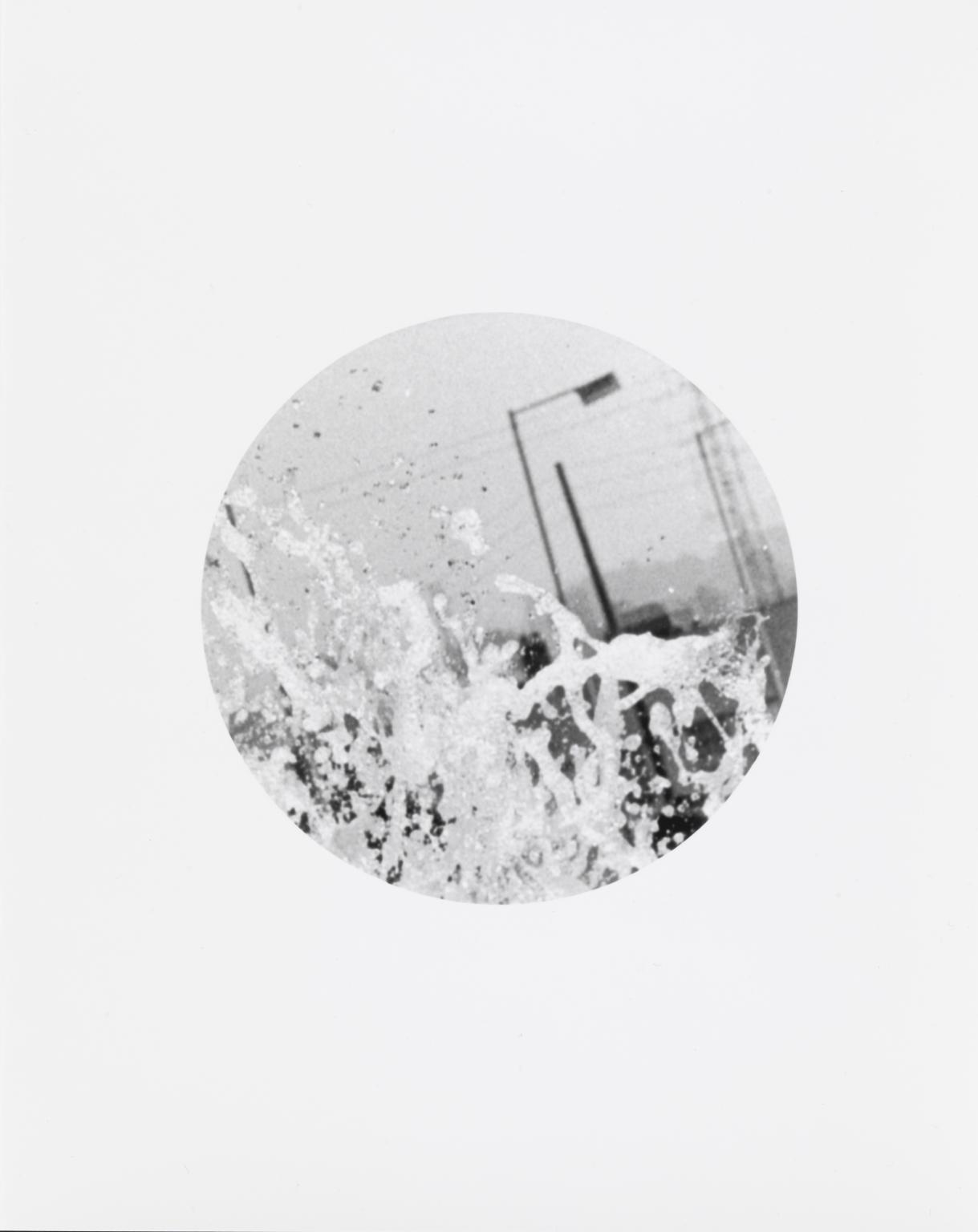
Adam Broomberg, Oliver Chanarin, Untitled (Fountain) 2010
10/28
artworks in Democracies
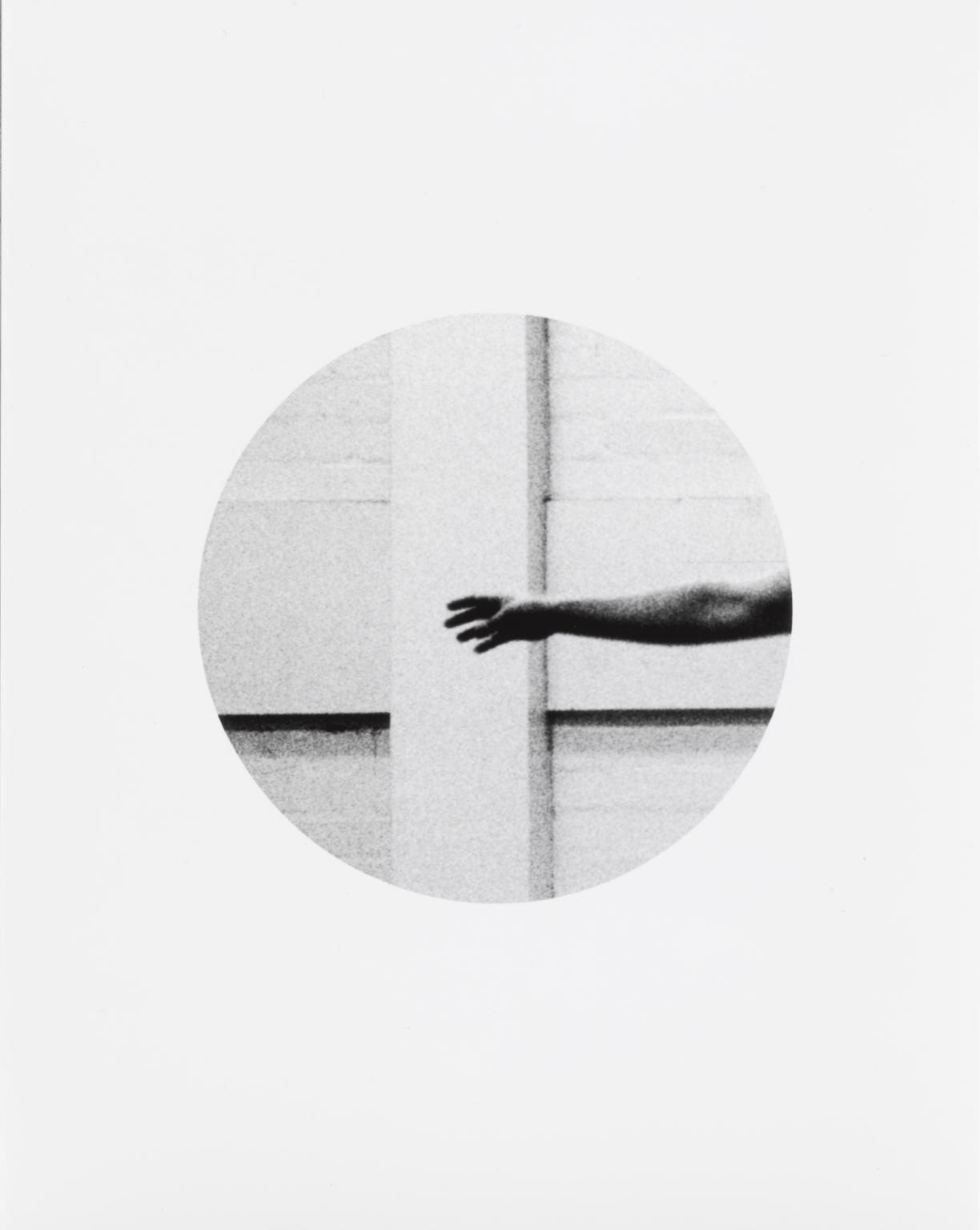
Adam Broomberg, Oliver Chanarin, Untitled (Right arm) 2010
11/28
artworks in Democracies
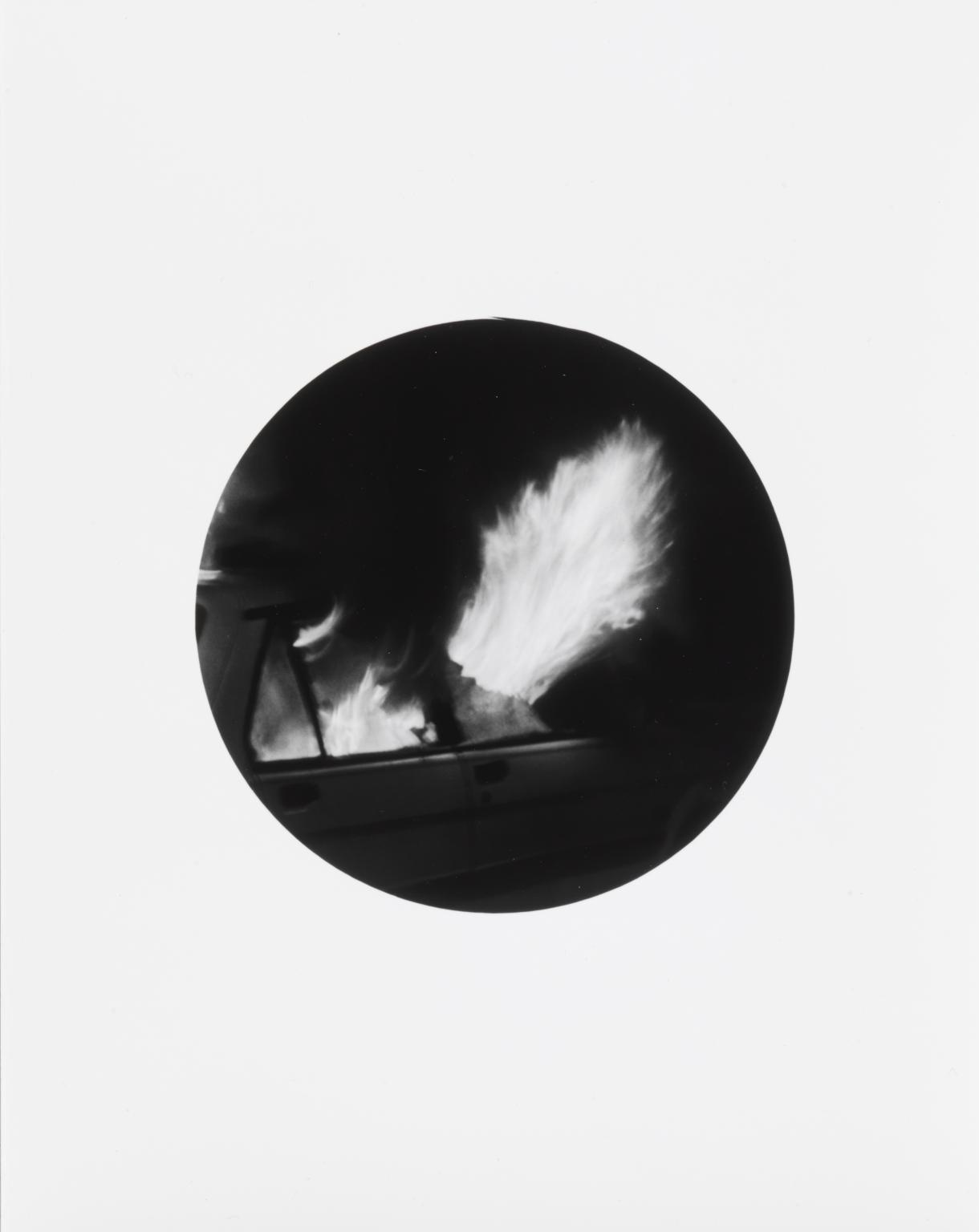
Adam Broomberg, Oliver Chanarin, Untitled (Car on fire) 2010
12/28
artworks in Democracies
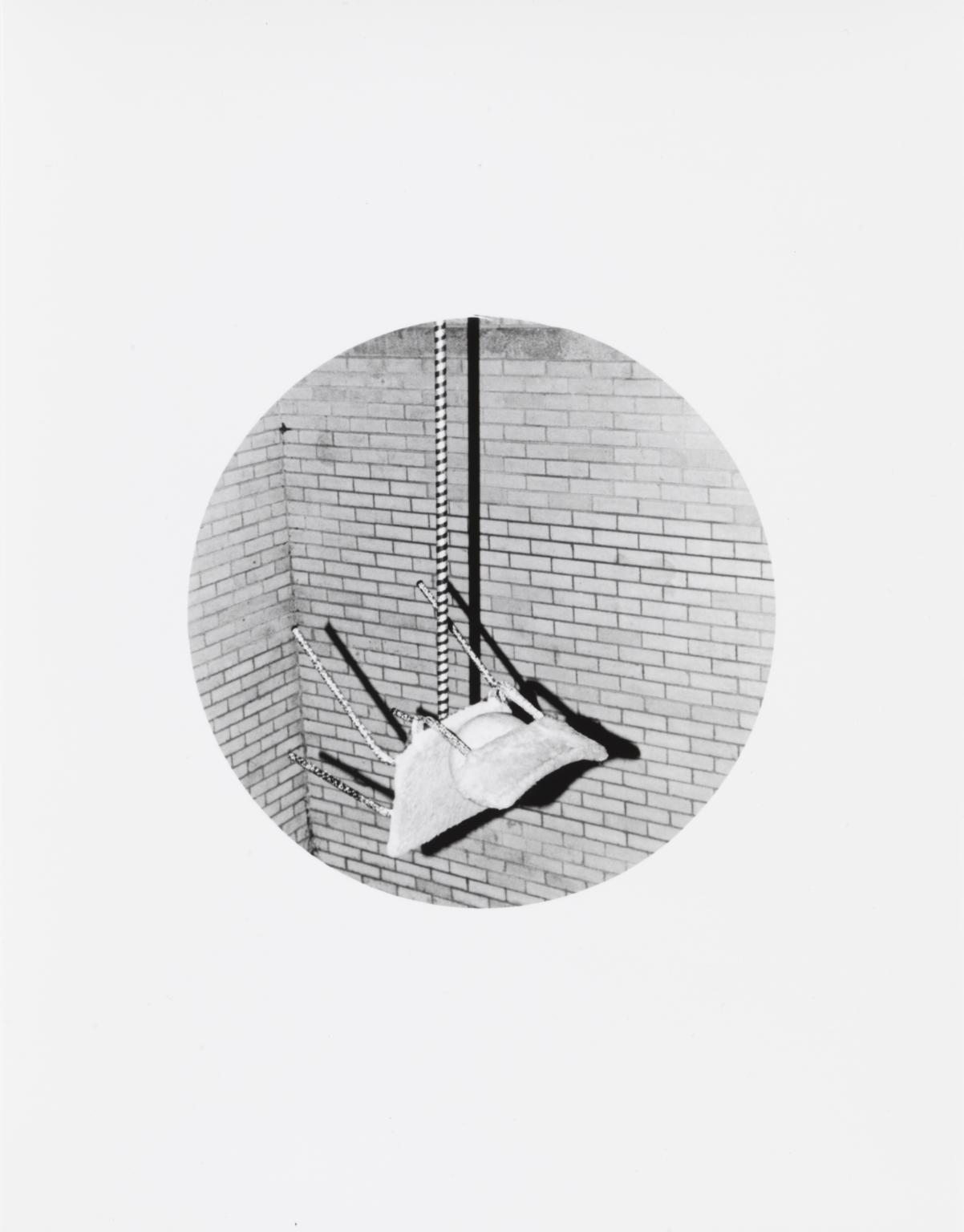
Adam Broomberg, Oliver Chanarin, Untitled (Chair balancing on stick) Date not known
13/28
artworks in Democracies
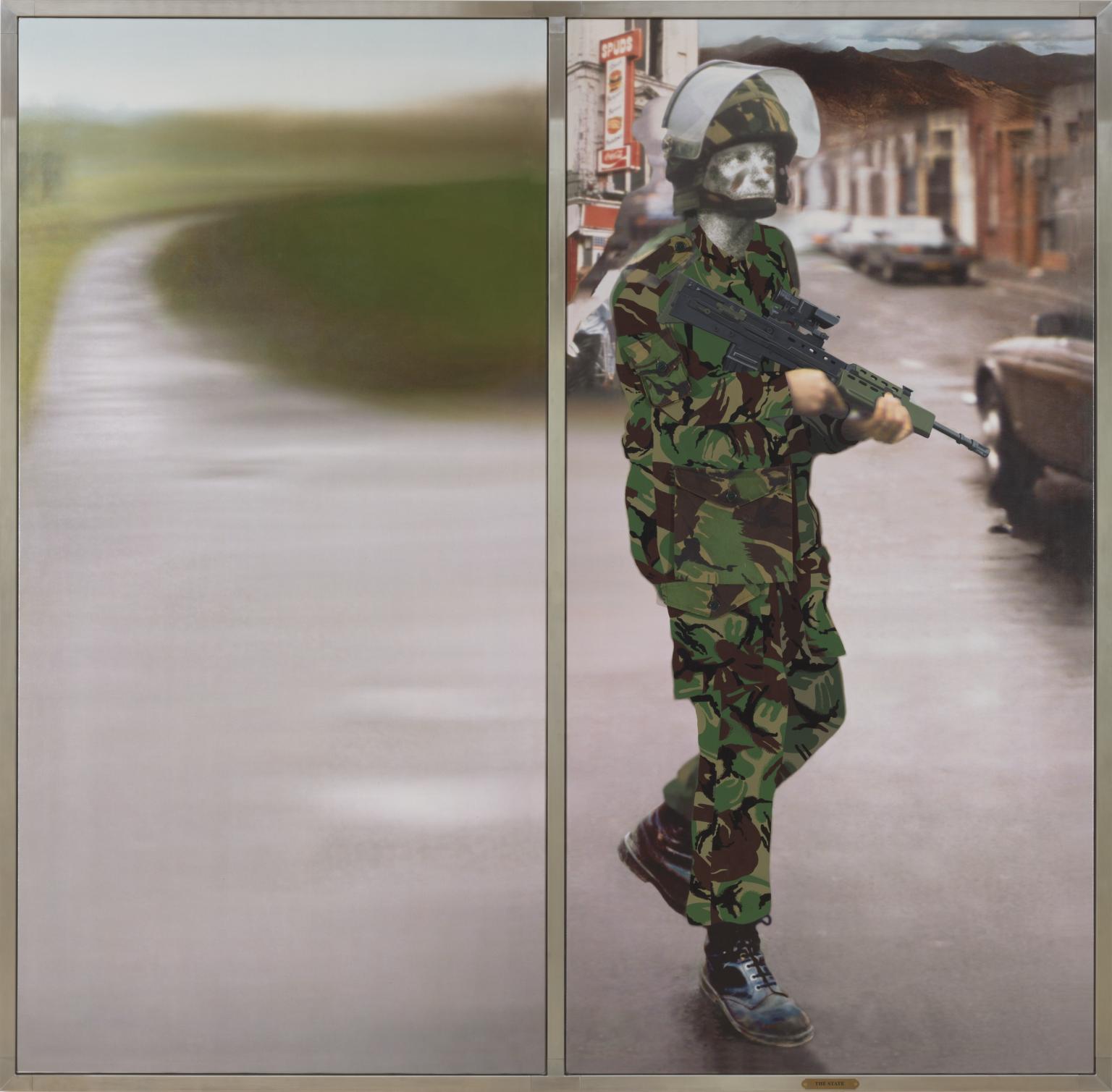
Richard Hamilton, The state 1993
Hamilton’s image of a patrolling British soldier expresses the unease of the army’s equivocal position in Northern Ireland. Brandishing a weapon, yet moving protectively backwards, he is both on the offensive and defensive. The rural Irish landscape and city streets behind him pose equal threats. Hamilton has incorporated real fabric into the soldier’s fatigues, merging pictorial representation and reality. The construction of images through costume and artifice has been a consistent concern in Hamilton's works.
Gallery label, November 2006
14/28
artworks in Democracies

Ian Hamilton Finlay, Quin Morere 1991
15/28
artworks in Democracies
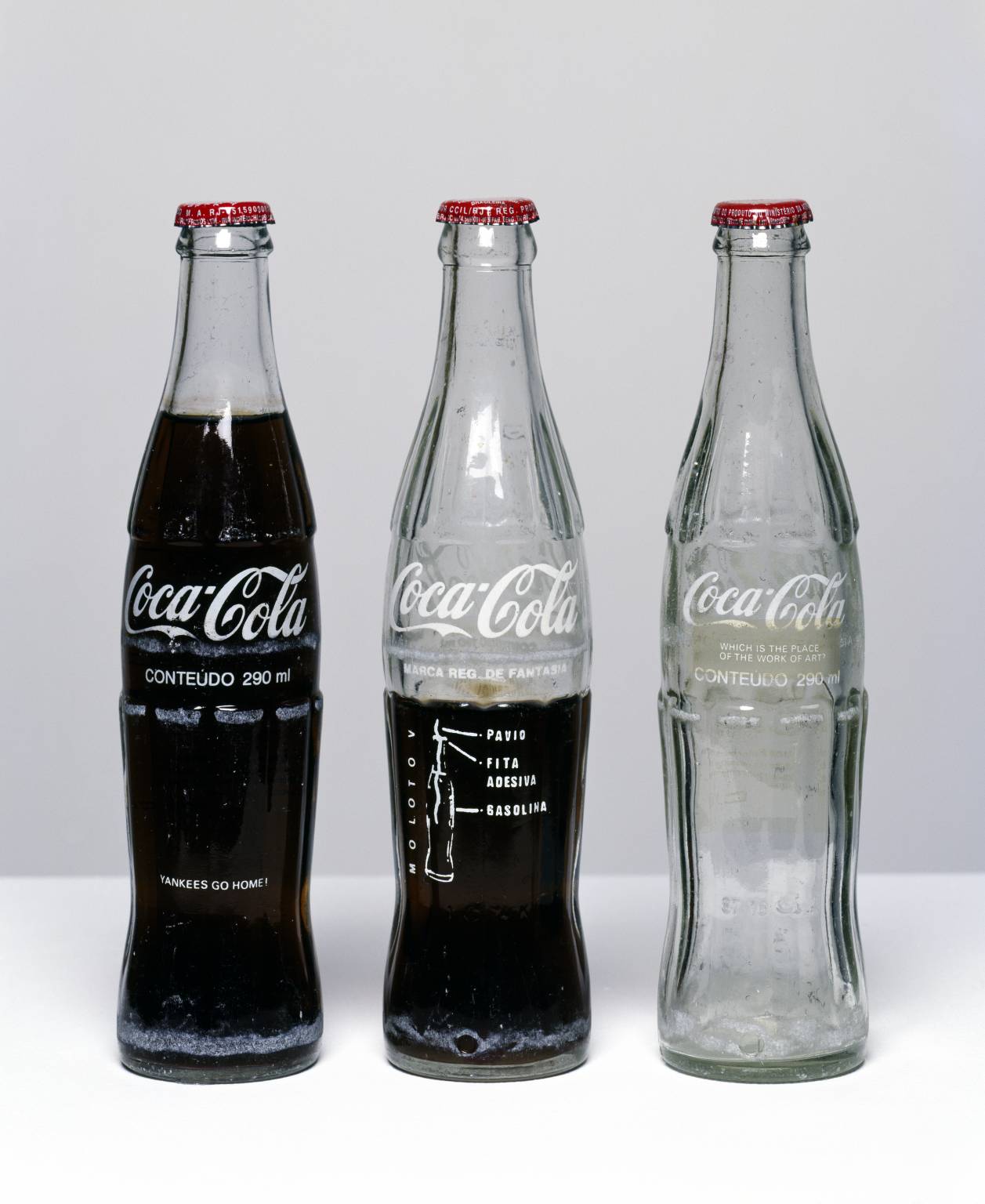
Cildo Meireles, Insertions into Ideological Circuits: Coca-Cola Project 1970
Meireles altered a series of Coca-Cola bottles, by printing slogans such as ‘Yankees go home’ or instructions for making Molotov cocktails on them. He put them back into circulation in what he described as an act of subversive ‘mobile graffiti’, enacted under Brazil’s military dictatorship. He saw the system of recycling empty bottles as a way of enabling a political message to circulate surreptitiously. He has compared the Coca-Cola bottles to ‘messages in bottles, flung into the sea by victims of shipwrecks’.
Gallery label, February 2016
16/28
artworks in Democracies
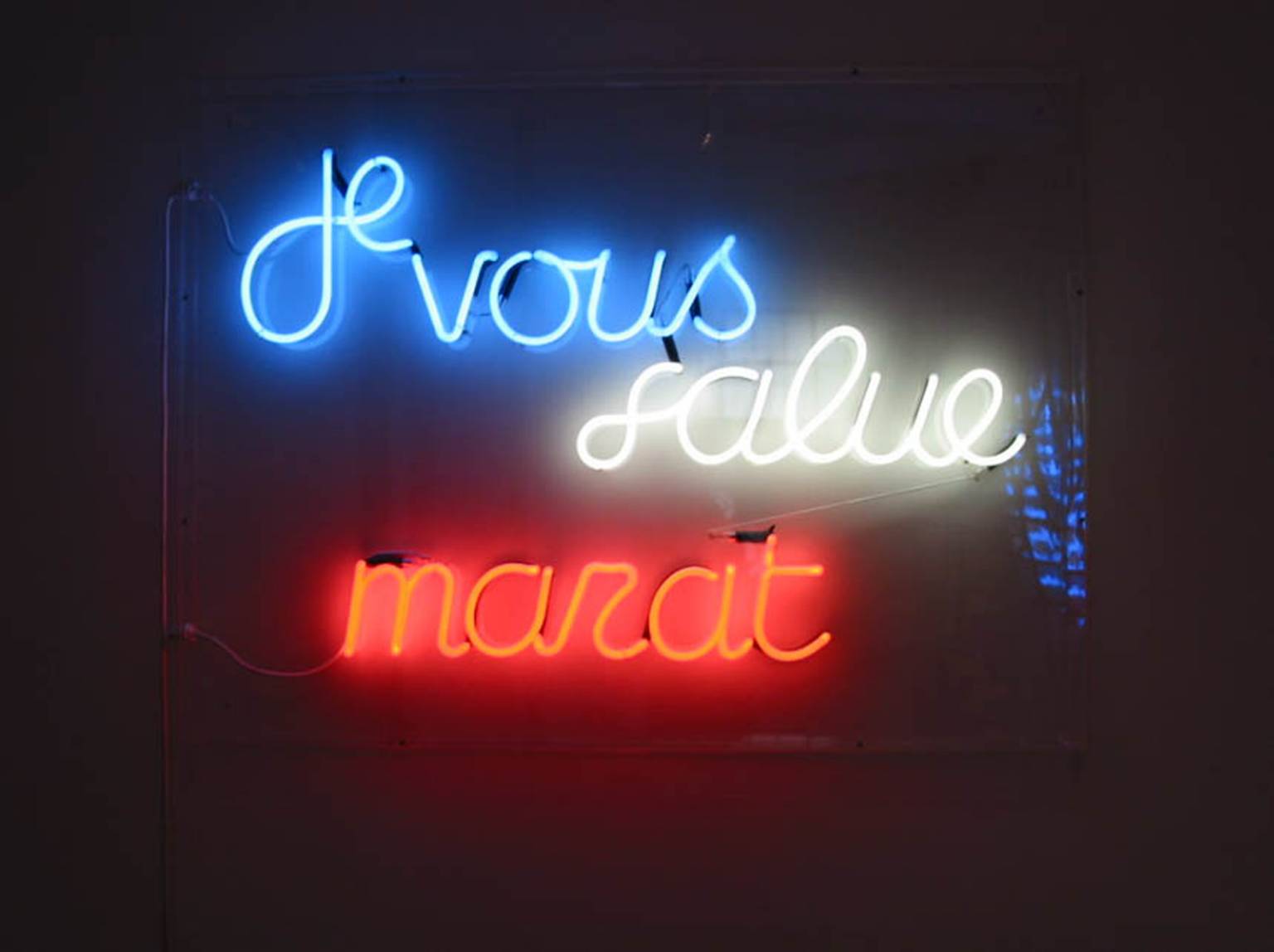
Ian Hamilton Finlay, Je Vous Salue Marat 1989
17/28
artworks in Democracies
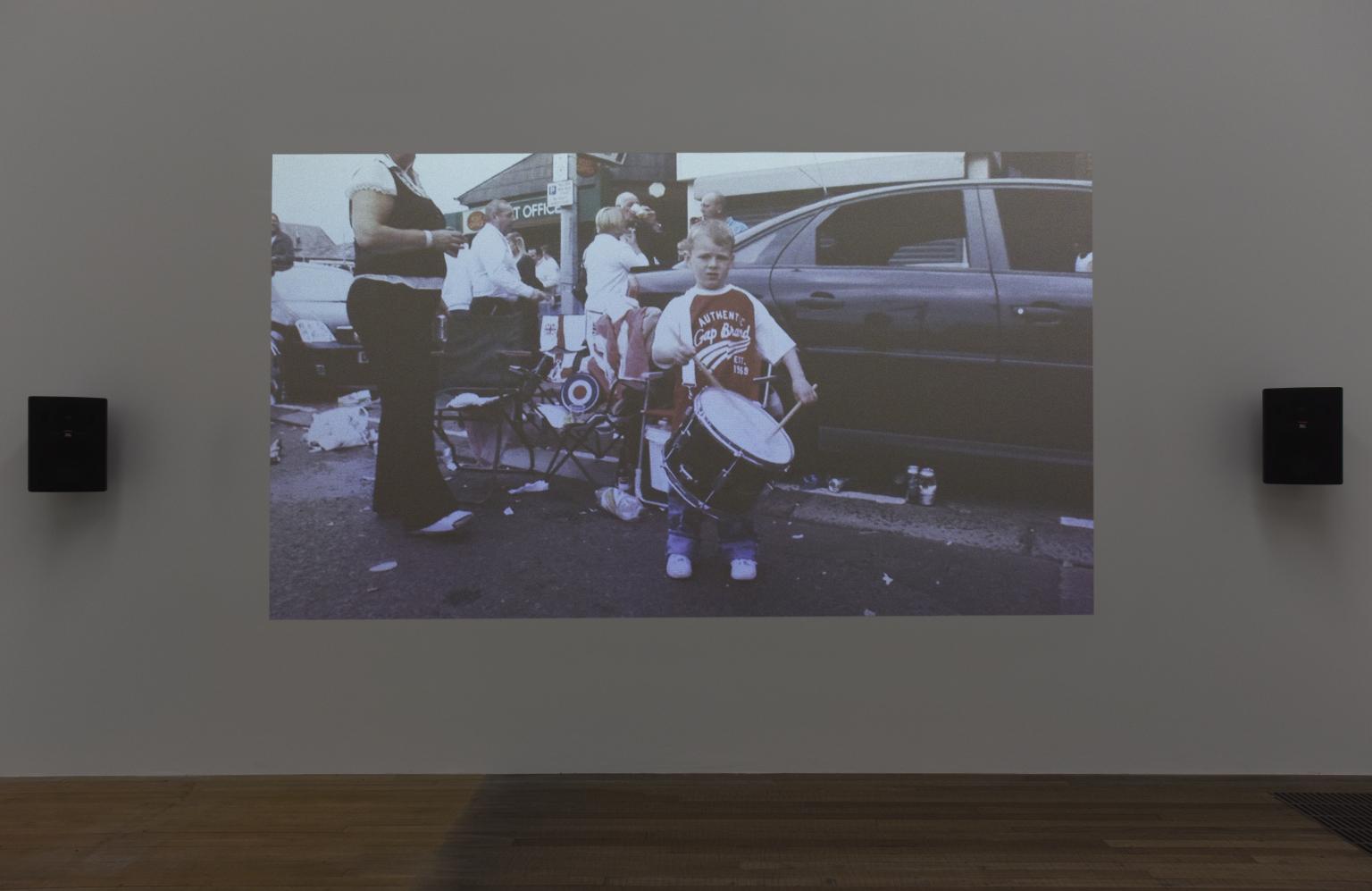
Artur Zmijewski, Democracies 2009
Aiming to blend into the crowd as much as possible, Zmijewski and his cameramen filmed a series of politically charged gatherings, including demonstrations, military parades and memorial services. Many of the events are extreme right-wing and nationalistic, reflecting what the artist sees as a general cultural shift in Europe. ‘I was less interested in the rightness or justice of the cause’, Zmijewski has said, ‘but more in this inner drive that moves people to debate, to publicly show their own needs, demands, requests, opinions – and to defend them with their own presence’.
Gallery label, November 2015
18/28
artworks in Democracies
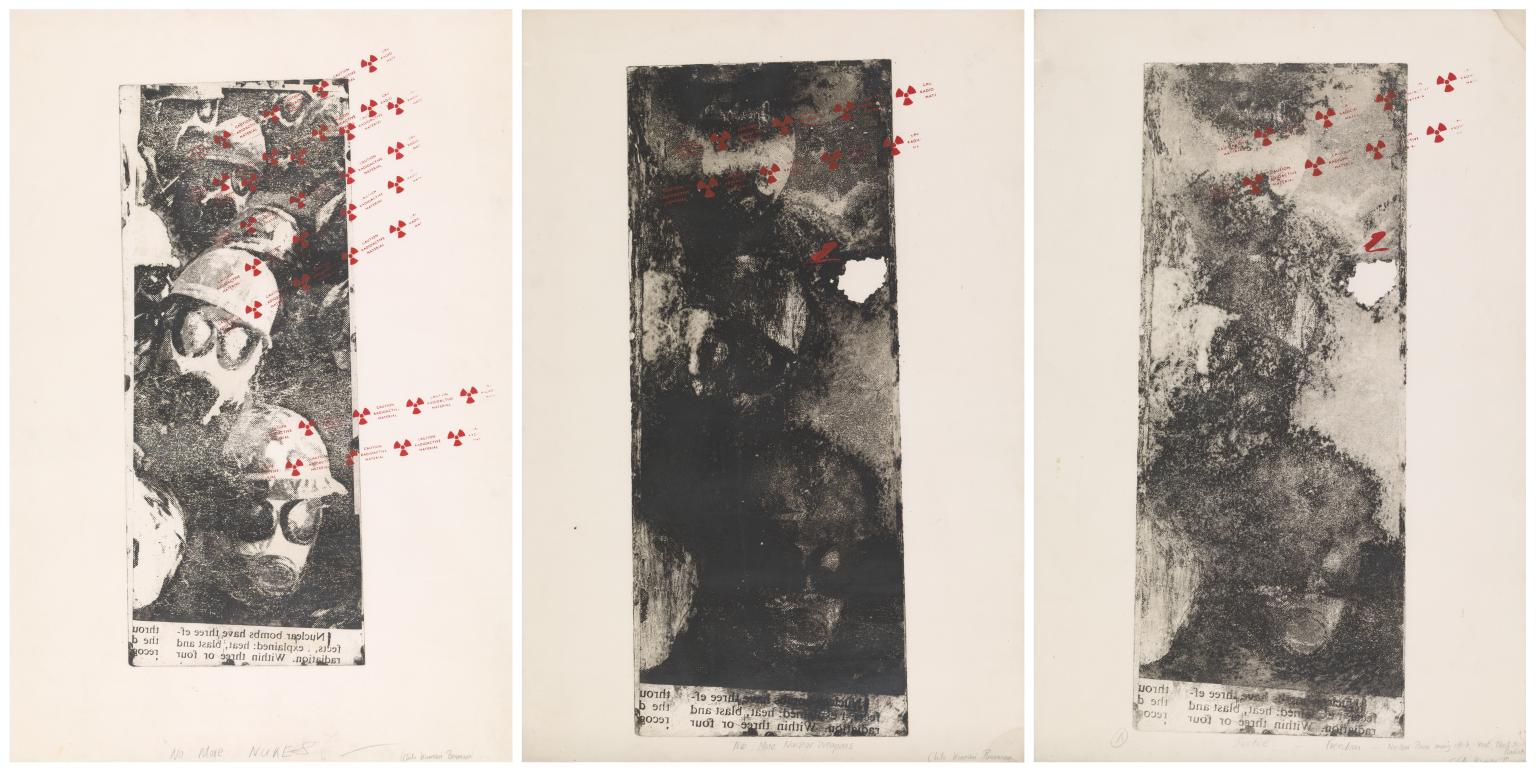
Chila Kumari Singh Burman MBE, Triptych No Nukes 1982
This is one of a group of six unique prints in Tate’s collection from Chila Kumari Burman’s Riot Series (Tate T14090–T14095), each of which is individually titled. They were made in 1981 and 1982 with the master printmaker Stanley Jones (born 1933) in the Printmaking Department at the Slade School of Fine Art in London, where Burman was a student at the time. The Printmaking Department had established a reputation for experimenting with a range of techniques and this can be seen in this series. After a variety of trials, Burman and Jones decided to work with a combination of processes in each print – etching and silkscreen, etching and aquatint or etching and lithograph. The tensions generated by the combination and overlaying of two material techniques embodied the violence embedded within the subject matter of the work, echoing the theme of conflict as well as affecting the final appearance of the prints. The historian Lynda Nead has written about Burman’s process of layering images:
19/28
artworks in Democracies
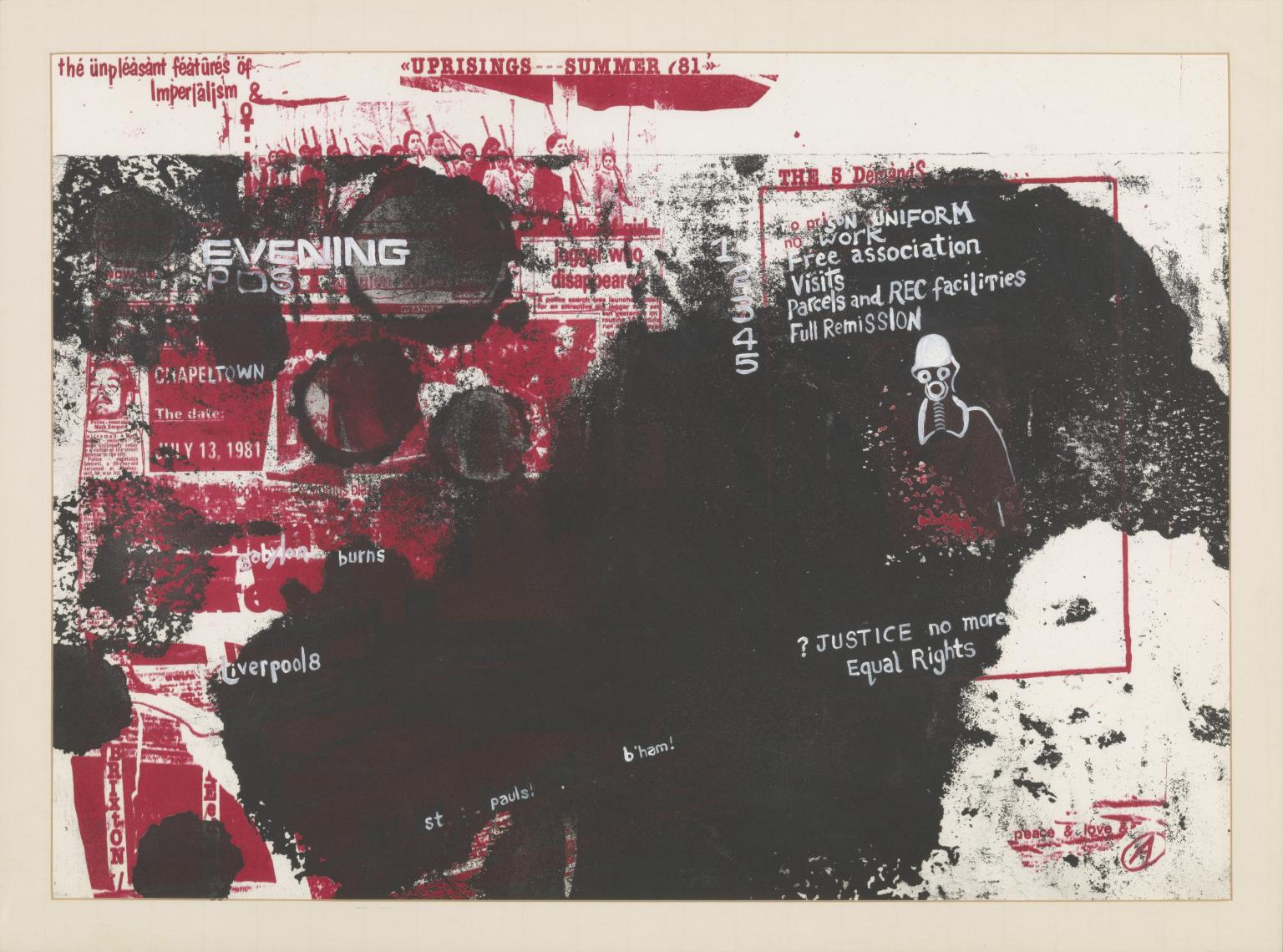
Chila Kumari Singh Burman MBE, If There is No Struggle, There is No Progress - Uprisings 1981
This is one of a group of six unique prints in Tate’s collection from Chila Kumari Burman’s Riot Series (Tate T14090–T14095), each of which is individually titled. They were made in 1981 and 1982 with the master printmaker Stanley Jones (born 1933) in the Printmaking Department at the Slade School of Fine Art in London, where Burman was a student at the time. The Printmaking Department had established a reputation for experimenting with a range of techniques and this can be seen in this series. After a variety of trials, Burman and Jones decided to work with a combination of processes in each print – etching and silkscreen, etching and aquatint or etching and lithograph. The tensions generated by the combination and overlaying of two material techniques embodied the violence embedded within the subject matter of the work, echoing the theme of conflict as well as affecting the final appearance of the prints. The historian Lynda Nead has written about Burman’s process of layering images:
20/28
artworks in Democracies
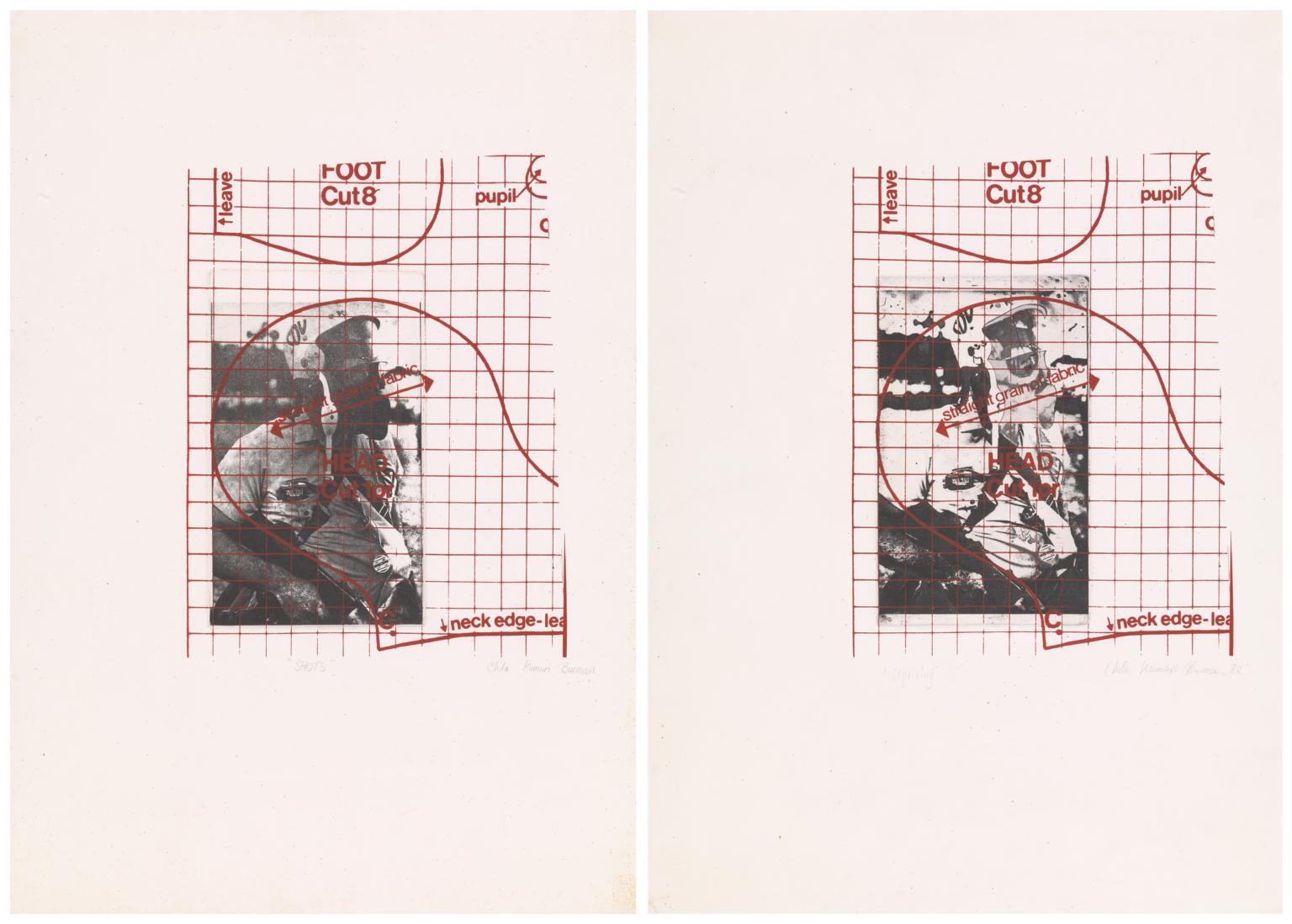
Chila Kumari Singh Burman MBE, Cut - Foot - Pupil- Uprisings 1981
This is one of a group of six unique prints in Tate’s collection from Chila Kumari Burman’s Riot Series (Tate T14090–T14095), each of which is individually titled. They were made in 1981 and 1982 with the master printmaker Stanley Jones (born 1933) in the Printmaking Department at the Slade School of Fine Art in London, where Burman was a student at the time. The Printmaking Department had established a reputation for experimenting with a range of techniques and this can be seen in this series. After a variety of trials, Burman and Jones decided to work with a combination of processes in each print – etching and silkscreen, etching and aquatint or etching and lithograph. The tensions generated by the combination and overlaying of two material techniques embodied the violence embedded within the subject matter of the work, echoing the theme of conflict as well as affecting the final appearance of the prints. The historian Lynda Nead has written about Burman’s process of layering images:
21/28
artworks in Democracies

Chila Kumari Singh Burman MBE, Three Mug Shots in a Row 1982
This is one of a group of six unique prints in Tate’s collection from Chila Kumari Burman’s Riot Series (Tate T14090–T14095), each of which is individually titled. They were made in 1981 and 1982 with the master printmaker Stanley Jones (born 1933) in the Printmaking Department at the Slade School of Fine Art in London, where Burman was a student at the time. The Printmaking Department had established a reputation for experimenting with a range of techniques and this can be seen in this series. After a variety of trials, Burman and Jones decided to work with a combination of processes in each print – etching and silkscreen, etching and aquatint or etching and lithograph. The tensions generated by the combination and overlaying of two material techniques embodied the violence embedded within the subject matter of the work, echoing the theme of conflict as well as affecting the final appearance of the prints. The historian Lynda Nead has written about Burman’s process of layering images:
22/28
artworks in Democracies
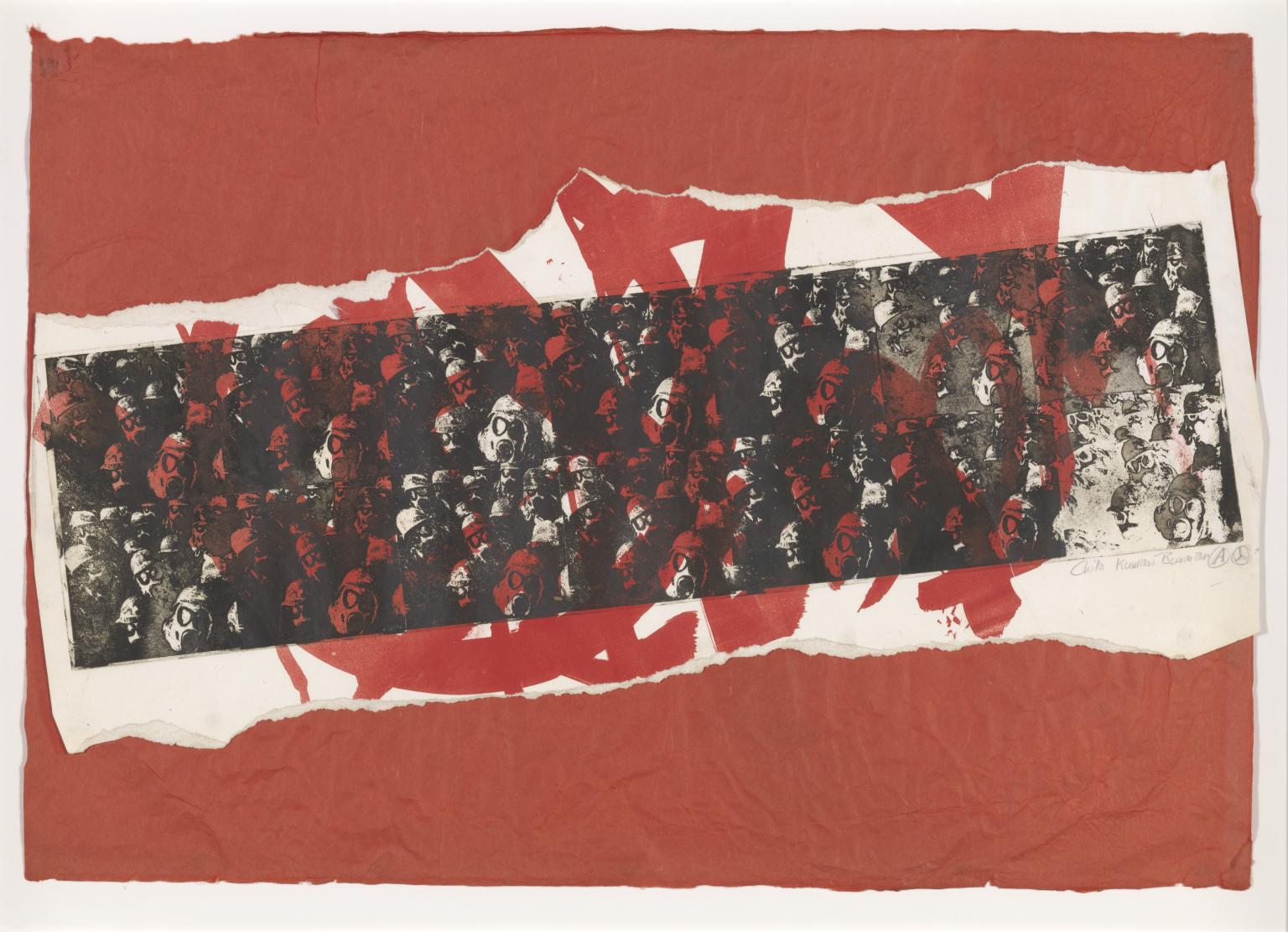
Chila Kumari Singh Burman MBE, Red Riots on Indian Paper 1981
This is one of a group of six unique prints in Tate’s collection from Chila Kumari Burman’s Riot Series (Tate T14090–T14095), each of which is individually titled. They were made in 1981 and 1982 with the master printmaker Stanley Jones (born 1933) in the Printmaking Department at the Slade School of Fine Art in London, where Burman was a student at the time. The Printmaking Department had established a reputation for experimenting with a range of techniques and this can be seen in this series. After a variety of trials, Burman and Jones decided to work with a combination of processes in each print – etching and silkscreen, etching and aquatint or etching and lithograph. The tensions generated by the combination and overlaying of two material techniques embodied the violence embedded within the subject matter of the work, echoing the theme of conflict as well as affecting the final appearance of the prints. The historian Lynda Nead has written about Burman’s process of layering images:
23/28
artworks in Democracies
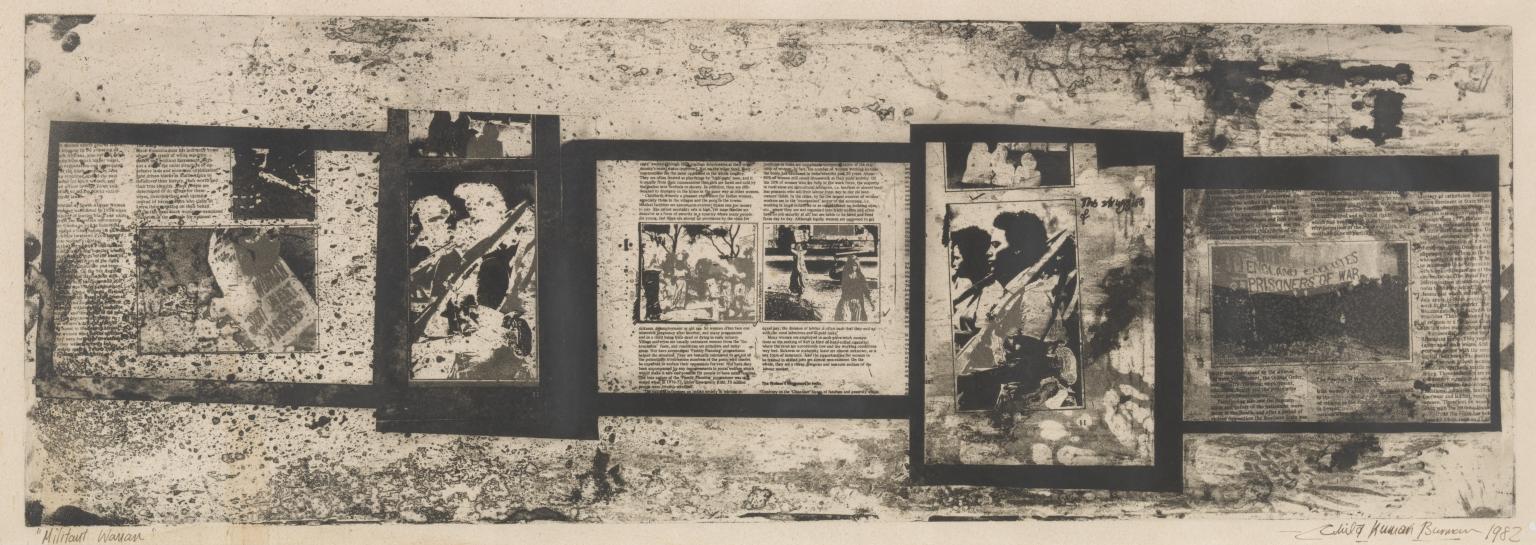
Chila Kumari Singh Burman MBE, Militant Women 1981
This is one of a group of six unique prints in Tate’s collection from Chila Kumari Burman’s Riot Series (Tate T14090–T14095), each of which is individually titled. They were made in 1981 and 1982 with the master printmaker Stanley Jones (born 1933) in the Printmaking Department at the Slade School of Fine Art in London, where Burman was a student at the time. The Printmaking Department had established a reputation for experimenting with a range of techniques and this can be seen in this series. After a variety of trials, Burman and Jones decided to work with a combination of processes in each print – etching and silkscreen, etching and aquatint or etching and lithograph. The tensions generated by the combination and overlaying of two material techniques embodied the violence embedded within the subject matter of the work, echoing the theme of conflict as well as affecting the final appearance of the prints. The historian Lynda Nead has written about Burman’s process of layering images:
24/28
artworks in Democracies

Lubaina Himid CBE RA, The Carrot Piece 1985
The Carrot Piece shows a white man failing to tempt a black woman with a carrot. Her arms are already full with everything she needs. Himid says that when the work was made, cultural institutions ‘needed to be seen’ to be integrating black people into their programmes and ‘we as black women understood how we were being patronised ... to be cajoled and distracted by silly games and pointless offers. We understood, but we knew what sustained us… and what we really needed to make a positive cultural contribution: self-belief, inherited wisdom, education and love.’
Gallery label, July 2017
25/28
artworks in Democracies
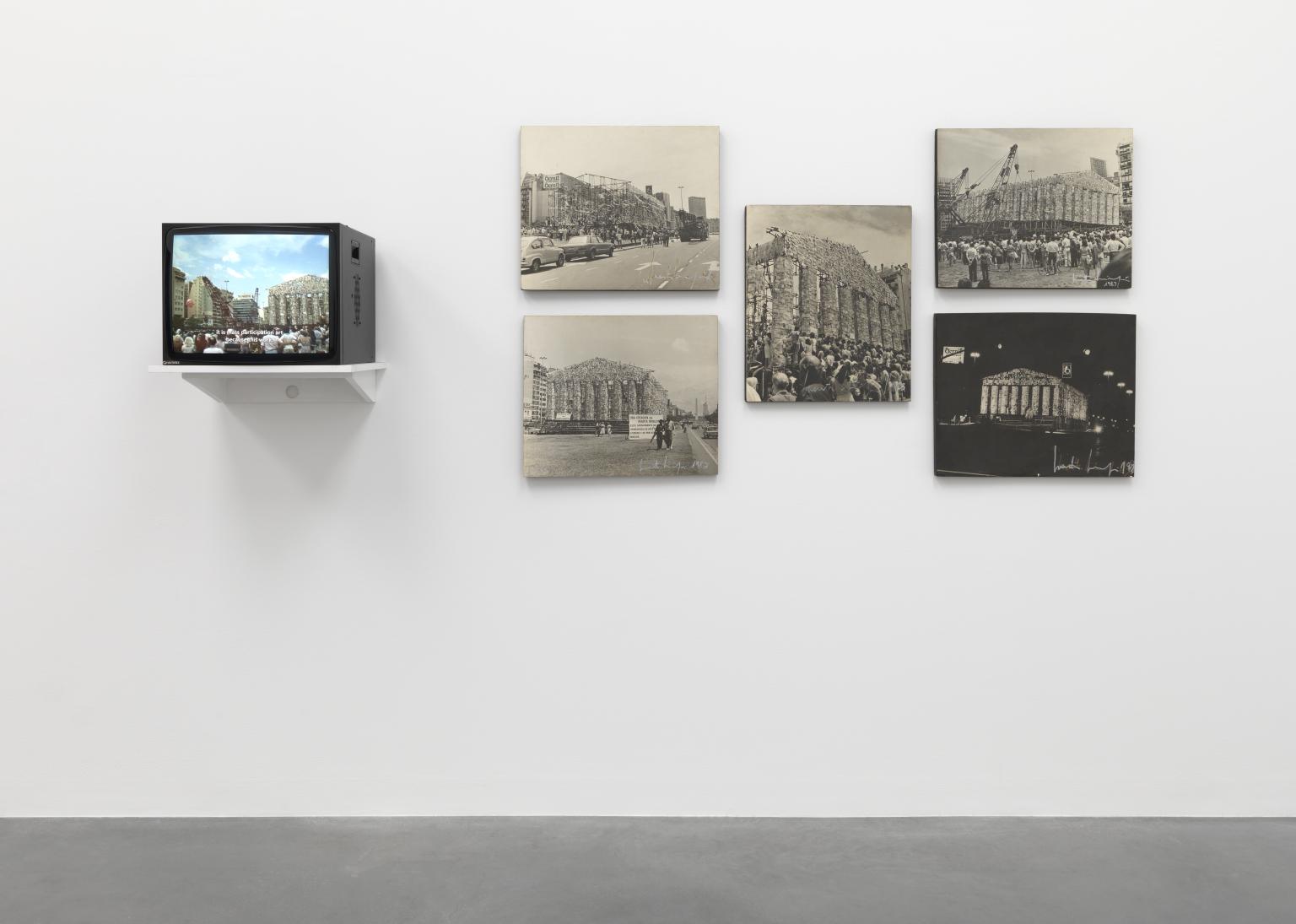
Marta Minujín, The Parthenon of Books 1983
The Parthenon of Books 1983 is the documentary record of a project by Marta Minujín in which she reconstructed the classical Greek temple of the Parthenon from the Acropolis in Athens out of books. In its current form the work consists of five black and white photographs showing various stages of the construction of the temple and a video recording the event and public reaction to it. The photographs are unique prints.
26/28
artworks in Democracies
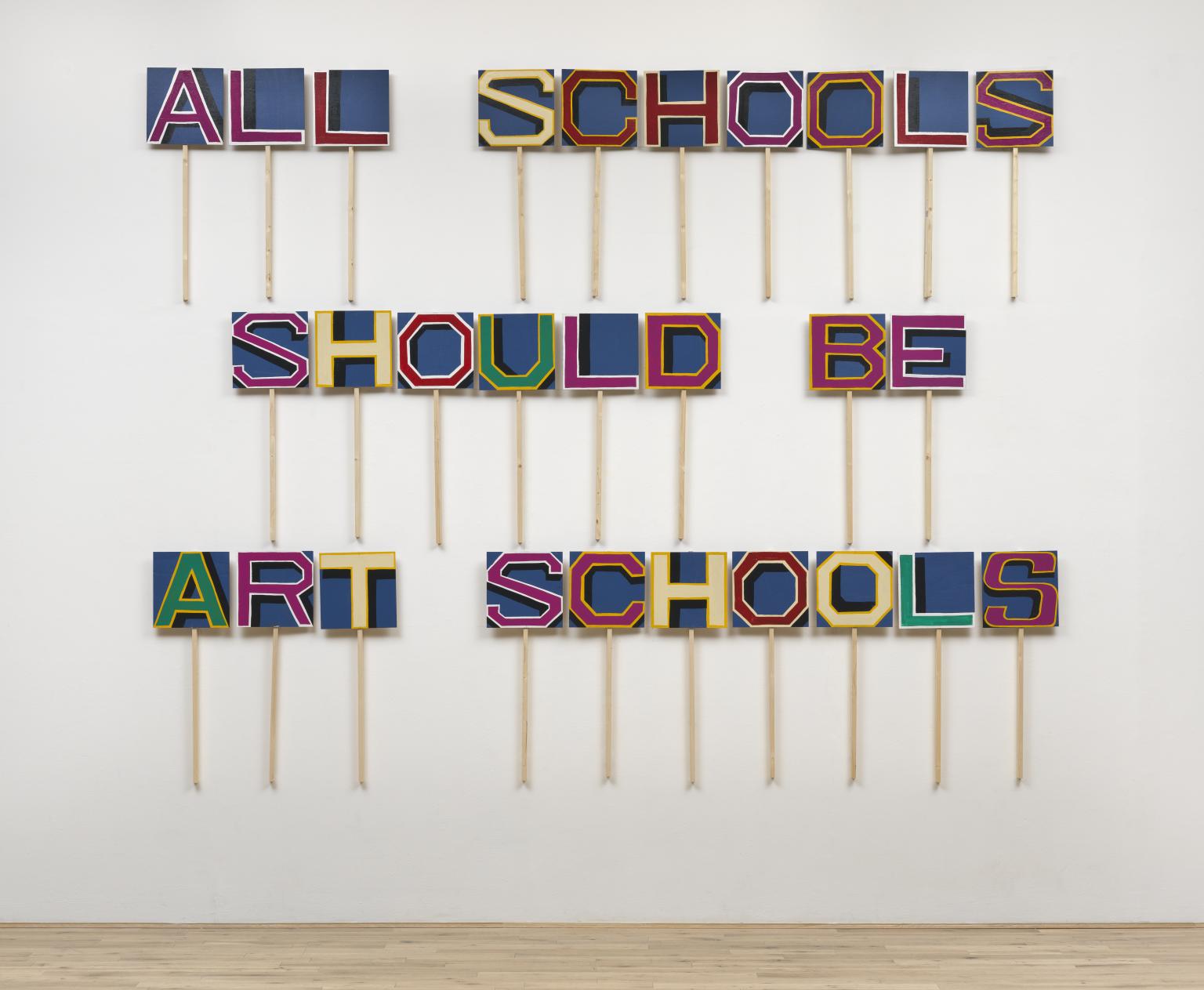
Bob and Roberta Smith, All Schools Should be Art Schools 2016
All Schools Should Be Art Schools 2016 consists of twenty-eight placard signs, each of which is made of a square sheet of wood pinned to a wooden stake. Each sign is painted with a different capital letter on a blue background to fill the square. The letters have been variously painted in purple, green, cream and red and all are drawn in an angular style save for one ‘S’, the final letter of the work, which is curvilinear. The letter forms are outlined in yellow, cream or white and emphasised by drop shadows. Together they spell out the slogan and title of the work, ‘All Schools Should Be Art Schools’. The back of each board is unpainted bears a letter (corresponding to the letter painted on the front) and a number which indicates the order in which the panels should be installed.
27/28
artworks in Democracies
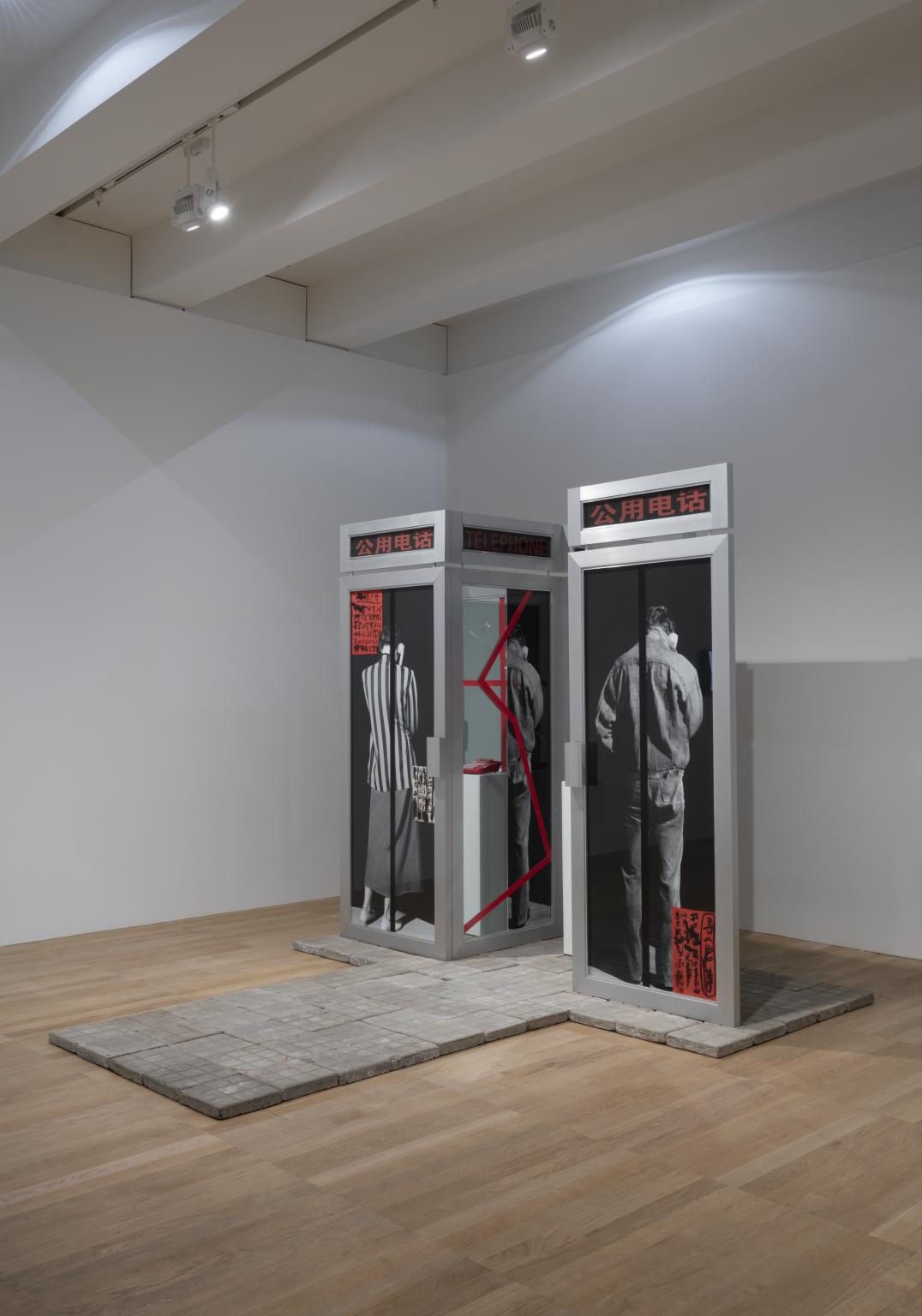
Xiao Lu, Dialogue 1989, remade 2015
Dialogue is an installation that comprises two life-size aluminium alloy telephone booths, a mirror, a pedestal, a red telephone and cement paving stones. On the left phone booth, an image of the back of a female figure holding a receiver is silkscreened over the glass, and on the right phone booth the back of a male figure is depicted. In the middle of the two phone booths is a red telephone on a white plinth, with the receiver dangling down. Behind the phone is a mirrored panel with two bullet holes referencing an action carried out by the artist when the work was displayed in the exhibition China/Avant-Garde at the National Art Gallery, Beijing in 1989. The sculpture is raised on cement paving stones, and purposely resembles the public phone booths found on the streets of China in the late 1980s.
28/28
artworks in Democracies
Art in this room




























You've viewed 6/28 artworks
You've viewed 28/28 artworks
